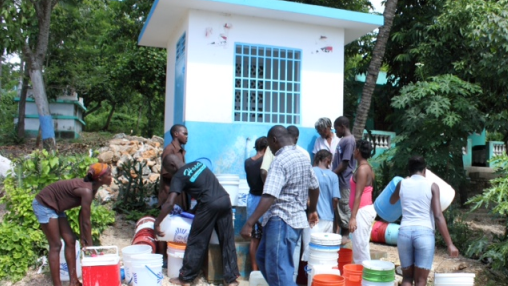Challenge
While more Haitians have access to improved drinking water over the last decade, reducing the gap between urban and rural water access remains a challenge. In rural parts of Haiti, less than half of the population has access to improved water sources and only 26 percent of people have access to improved sanitation.
The limited resources available for water supply outside of metropolitan Port-au-Prince were focused on urban water supply in secondary towns. In addition, the Ministry of Health’s rural water units had limited funds and were inactive. There was also no specific institution responsible for sanitation. Without an institutional presence in rural areas, it was difficult to prioritize investments in order to reach the neediest citizens. Local communities could not properly maintain infrastructure and many rural water systems were managed by water committees often consisting of unpaid volunteers elected by the community. Most water committees have been unable to collect sufficient funds for operation or routine maintenance.
Adding to these challenges, a cholera epidemic struck Haiti in October 2010. The lack of clean water and sanitation in rural areas made people more vulnerable to the disease, fueling the spread of the epidemic.
Solution
The World Bank partnered with the State and Peace-Building Fund (SPF) and the Haitian National Water and Sanitation Directorate (DINEPA) to address the challenges of increasing access to water supply and sanitation services in rural communities of the South department of Haiti. The Project introduced a professional management model involving local, professional water operators (OPs), which were selected and contracted by the community to operate, maintain and manage the water supply systems. It also promoted cost recovery, metering, and the use of water kiosks, as well as gravity-fed piped systems to minimize potential technical issues. Where pumping was necessary and cost-effective, the preference was to use renewable energy, such as solar.
The communities were selected by evaluating their willingness to pay for water services and by using a participatory approach providing communities with a series of choices for different water service levels – household connection or water kiosk – and different tariff structures.
In line with the national sanitation strategy, the Bank also conducted hygiene and sanitation promotion and training activities, focusing on the development of incentives to encourage Haitians to build and maintain their own toilets.
Results
The main results of the water supply interventions include:
- More than 50,000 people served by the construction and rehabilitation of 12 drinking water systems. Systems were equipped with a chlorinator and each operator has a test kit to measure water quality;
- New professional management model, serving 44,000 people, has been successfully established in 9 communities. The water and sanitation committees (CAEPAs) and OPs were trained in community mobilization, conflict resolution, billing and accounting, meter reading and repairing, chlorination as well as plumbing;
- 1,210 household connections to water networks were installed, and 54 water distribution kiosks and 34 public fountains were built or rehabilitated;
- 8 boreholes with hand pumps were installed, serving 4,000 people.
- Following the cholera outbreak, members of CAEPAs, OPs and plumbers were trained in the basic response to cholera and other waterborne diseases;
The main results of the sanitation interventions are:
- 13 public schools and one health center benefitted from sanitation works, reaching more than 7,000 students and teachers;
- Sanitation works included: 24 latrines and 26 urinals built or rehabilitated and 27 hand-washing stations built;
- 14 masons were trained to build latrines in the participating communities;
- Hygiene and sanitation promotion campaigns were launched on two regional radio stations and training sessions on hygiene and sanitation promotion were organized in schools and health centers, contributing to increasing the proportion of households owning and using a latrine;
- 35% of households surveyed in beneficiary communities reported having built a latrine with their own resources in the last 5 years.
Bank Group Contribution
The Bank contributed to DINEPA’s Rural Water and Sanitation Program through a $5 million IDA Grant and the State and Peace-Building Fund contributed an additional $5 million. This professional operator management model has been adopted and scaled up by the Inter-American Development Bank. Subsequently, the WB and IDB have been coordinating investments and sharing lessons learned.
Moving Forward
As a result of the successful implementation of the professional operator management model in the South department of Haiti, the Bank is considering scaling up the model at the national level and continuing support to DINEPA.
Beneficiaries
By the end of November 2013, more than 50,000 people will have received improved water supply services as a result of the project. The Project has also financed the construction of school latrines for more than 7,000 students and teachers.

